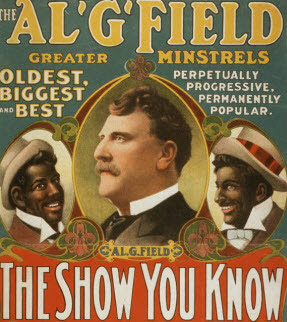I'm starting in the 1900s but it goes back much further in time. This is where the tangles of history get complicated. In order for white folks to create theatrical minstrel shows you had to have black people, Christianity and spirituals.
There were former slaves that wanted to convert to Christianity. There were other freed men and women that were strongly encouraged or given no faith based choice in the matter. According to the New York Public Library Performing Desk Reference, the freed slaves looked at churches or religious groups that were similar to their African music practices.
Despite heavy segregation, there was a cross pollination of African and American/British spiritual music influences. Those influence moved from the sacred to the secular.
You also had the performances of the Fisk Jubilee Singers who traveled the world singing and raising money to support Fisk University. Their performances was another introduction to African American performers and music. These performers were talented, professional and presented the highest caliber of musicianship.
Yet, they didn't fit the stereotypical image of black people. According to the Fisk Jubilee Singers web site:
The first concerts were in small towns. Surprise, curiosity and some hostility were the early audience response to these young black singers who did not perform in the traditional “minstrel fashion.”However, white performers were paying attention. About 1820 or so, a white performer named Thomas "Daddy" Rice observed a black street singer or a black stable hand (could have been the same person, it isn't clear from my readings) singing a song called "Jim Crow."

Thomas Rice put burnt cork on his face and started performing his version of the song. It was a hit and the song becomes an American standard.
Imitation is the sincerest form of making a dollar and other white performers jumped on the minstrel black face cash wagon. Soon almost any white performer with a lick of skill was in black face make-up and traveling the country performing.
Putting on a minstrel show was inexpensive, you didn't need a lot of props and you literally could borrow, appropriate and source your material from freeman performers. In addition, white performers could draw upon their own stereotypical views of what they thought they knew about black people.
Make no mistake, in the context of the time minstrel shows were very popular with both white and black audiences. Rich folks went to the opera, broke folks went to the minstrel shows.
Make that white broke folks. Africans and African Americans were not permitted to perform or be in attendance at a theatrical performance. Unless the theater had a separate performance for the non-white population they would have seen minstrel shows as part of carnivals, medicine shows or traveling troops of performers.
So in essence you had white performers appropriating content or inspiration from black performers and adding an overlay of stereotypical images to perform before a white audience.
Like I said, this is complicated. Ok, next up Minstrel 101 for sure.
Resources for Minstrel History
George Mason University Roy Rosenzweig Center for History and New Media Minstrel Show History of the original Fisk Jubilee Singers
Library of Congress Minstrel Poster Collection - Al "G" Field
Musicals1o1.com page on Minstrel performances
The New York Public Library Performance Art Desk Reference - The Birth of American Popular Music Pages 239 - 242 and the NYPL On-line search collection for Minstrel Shows
No comments:
Post a Comment